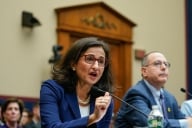You have /5 articles left.
Sign up for a free account or log in.
Of all the criticism leveled at the Obama administration’s plan to rate colleges, perhaps the most widespread critique is that a ratings system will harm disadvantaged students' access to higher education.
It’s a theme that permeated the Education Department’s public hearings on the ratings proposal last fall as well as the hundreds of pages of comments officials have received about the plan.
A ratings system in which colleges are judged based on the outcomes of their students, the argument goes, would create incentives for institutions to stop enrolling disadvantaged students, who may hurt the institution’s objective measures, such as graduation rates or post-graduate earnings.
Education Secretary Arne Duncan and his deputies who are currently developing the metrics for ratings system -- a draft of which has been promised by the end of the spring -- have said they are keenly aware of the potential for the plan to create such perverse incentives and unintended consequences. In order to prevent that, officials have said, they plan to compare colleges only to peer institutions with similar missions and also include metrics, such as the percentage of Pell Grant recipients, that reward colleges based on the access they already provide to low-income students.
But at least one university says it has already begun denying admission to “risky” applicants -- those who don’t meet the institution’s typical minimum standards for SAT scores and GPA -- over fears of how it would be rated under the Obama ratings proposal.
The president of that university said in a recent interview that the university is especially worried how the administration’s proposed rating system would judge its graduation rate, which is improving but still under 60 percent.
The university president would speak about the matter only on the condition of anonymity, but the president outlined to Inside Higher Ed how the university had changed its admissions process this year because of the ratings proposal.
Students applying to the university -- a mildly selective private nonprofit institution that is tuition-dependent -- typically need to meet minimum criteria of a 900 combined math/verbal SAT score and a grade-point average of about 2.8 in order to be considered for admission. However, each year the university selects a portion of applicants who are underqualified by those objective metrics but who show potential or have overcome particular difficulties in their lives. Those applicants are then vetted by a committee of faculty and counselors.
In recent years, the university has enrolled as much as between 18 and 20 percent of its freshman class of about 500 from that population of students, who are then often paired with a tutor or required to take a one-semester course that teaches college success strategies.
“Because of the special support for those students we have been comfortable thinking our commitment to providing opportunities for underserved populations remains a good idea,” the university president said.
This year, however, the university president said that “increased pressure for ‘outcomes’ from the government” has forced the institution to put together an incoming class made up of fewer than 15 percent of that “riskier” pool of applicants.
“Until we know what is happening with the president’s proposed rating system, I am not willing to risk the future of our institution by taking a gamble on these students, even though I believe that they are worth it,” the university president said.
The president provided detailed information -- but not names or other identifiable information -- on four students who normally would have made the admission cut despite their low G.P.A. and SAT scores, but were denied this year given the institution’s increased aversion to risk:
- A black female who is a recent immigrant from Africa and attended a public school in a suburb of a major urban area in the mid-Atlantic. Her GPA is 2.7 and her combined math/reading SAT is just under 700. “That’s not admissible,” the president said, but she has strong recommendations and her grades are good except for her junior year, when she took a challenging course load
- A Hispanic male from a public school in a relatively small town. His GPA is 2.4 and his combined SAT score is 900. “He wants to study accounting or business so he can help in his family’s business,” the president said. ““He’s a risk, but if he were to be successful it would be wonderful for him and his family.”
- A white male from a private high school in the Northeast. His GPA is 2.2 and his combined SAT score is 1150. “The low G.P.A. makes me think he didn’t try really hard, but his more-than-acceptable SAT makes you think he has the potential,” the president said, adding that the student had strong recommendations from his school principal and athletic coach.
- A black female who lives in a relatively small town. Her GPA is 2.3 and her combined SAT score is 700. Still, it appeared her grades were improving, the president said. She also came from a single-parent, working-class household and is highly involved with volunteer work, the president added.
The administration hasn’t yet said how graduation rates, or any metric, would factor into the rating system.
However, because graduation rates look four or six years into the past, “I can’t wait for them to make the decision because by the time they make the decision and implement it, it will be too late for my institution,” the university president said. “I know I’m not alone in this.”
David Hawkins, director of public policy and research for the National Association for College Admission Counseling, said he thought the university’s decision was premature.
“It seems a little early to be making that decisive of a move,” said Hawkins, adding that he had not heard of any other colleges making such changes at this point. He also said that the Education Department has indicated that it is willing to factor graduation rates into the rating system in a way that takes student populations into account.
Still, Hawkins said that he understands the motivation behind the decision, noting that institutions have long been under pressure, in part from commercial rankings like those from U.S. News, to admit more highly academically qualified students.
“One of the concerns we raised with the administration’s proposal is that those pressures exist and can be fairly detrimental to access,” he said.
“Once the framework [for the ratings system] is made clear, we are of the mind that there will be gaming behaviors -- there could be moves colleges make that will cut off access, though it depends on what the proposal is,” Hawkins said. “Admissions officers have a great deal of skepticism about whether this will work.”








